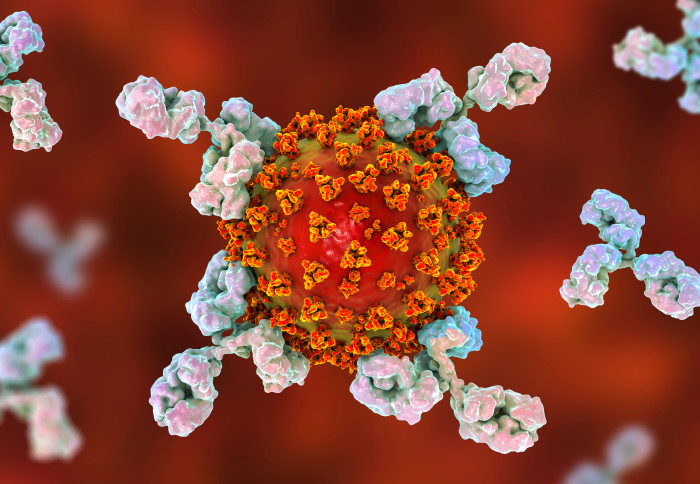COVID-19 immunity lasts over 4 months, but antibody and T cells can “uncouple"

Antibodies attacking SARS-CoV-2 virus
Majority carry neutralizing antibodies 16-18 weeks after mild or asymptomatic SARS-CoV-2 infection, but antibody and T cell responses can "uncouple".
This is according to new research published today in Science Immunology by scientists at Imperial College London, Queen Mary University of London, Barts and the London School of Medicine and Dentistry, University College London, Public Health England, Barts Health NHS Trust and Royal Free London NHS Foundation Trust.
The study analysed antibody and T cell responses in 136 London healthcare workers, 76 of whom had mild or asymptomatic infection dating back to the start of lockdown in March 2020.
The team found that 89 per cent of those analysed carried neutralizing antibodies 16-18 weeks following infection, and this was usually complemented by a multi-pronged T cell response.
However, the research also suggests that these two arms of protective immunity can become uncoupled, with some individuals showing T cell immunity but no evidence of antibodies, and vice versa.
Understanding COVID-19 protective immunity
From the outset of the pandemic, scientists across the globe have been working to understand how our immune system protects us against SARS-CoV-2, the virus that causes COVID-19 disease, and how long this protection lasts.
Much of the debate around protective immunity has focussed on the different roles of B cells, which make antibodies, and T cells, white blood cells which work in several different ways to help protect from viruses. Some previous studies have highlighted that binding antibody levels wane relatively quickly, while T cells may provide more durable protection.
Understanding how this careful choreography of immune responses works in people with mild or asymptomatic infection is particularly important as they represent the largest infected group. With this in mind, the study team set out to establish whether working adults with mild or asymptomatic infection would still show SARS-CoV-2 specific antibody and T cell responses more than four months after infection.
Insights into immune memory
16-18 weeks following infection, the team found that 89 per cent still had neutralizing antibodies capable of blocking virus entry, with 66 per cent showing high levels. Most also had T cells capable of recognising multiple different parts of the virus.
Overall, however, just over half of the healthcare workers had mismatched antibody and T cell responses and did not produce a T cell response specific to the virus' spike protein, with 15 per cent not producing a response to 'N', another key virus protein.
Importantly, the team found that T cell responses tended to be higher in those with the classic, defining symptoms of COVID-19 disease in comparison to those with asymptomatic infection. Asymptomatic infection resulted in weaker T cell immunity than symptomatic infection, but equivalent neutralizing antibody responses.
Implications for controlling the pandemic
The study highlights potential issues around using simple antibody binding tests to comment on past exposure or immunity to SARS-CoV-2. For example, 16 per cent of healthcare workers with proven infection with SARS-CoV-2 had a negative Euroimmun antibody binding test four months after infection, but demonstrated potentially protective neutralizing antibodies and/or T cell responses. Also, three per cent of healthcare workers with proven infection and a positive Euroimmun antibody binding test had no detectable neutralizing antibodies.
This study offers one of the most granular datasets yet of what happens in the most common type of SARS-CoV-2 infection – exposed asymptomatic adults or adults without severe disease or hospitalisation. For the majority of this group, there is evidence of immunity at 16-18 weeks comprising neutralizing antibodies (often at a level likely to protect), and this is usually complemented by multi-specific T cell responses.
This suggests that understanding protective immunity in the population will require careful and simultaneous scrutiny of T cell and antibody responses. The findings also emphasise the added value of looking at functionally protective neutralizing antibodies.
With the emergence of a new SARS-CoV-2 variant, many are asking what implications this poses for immunity either after natural infection or vaccination. The results of the current study reinforce the idea that most people, even following mild infection, carry antibody and T cell immunity to many parts of the virus (epitopes). While the new variant makes 17 changes to the virus' coding sequence, most aren’t necessarily within epitopes. Therefore, the immune system will likely still be able to recognise and respond to the virus.
'Discordant neutralizing antibody and T cell responses in asymptomatic and mild SARS-CoV-2 2 infection' by Catherine J. Reynolds et al. is published in Science Immunology.
DOI: 10.1126/science.abf3698
Corresponding author: Rosemary Boyton
Image: Shutterstock
Article text (excluding photos or graphics) © Imperial College London.
Photos and graphics subject to third party copyright used with permission or © Imperial College London.
Reporter
Ms Genevieve Timmins
Academic Services